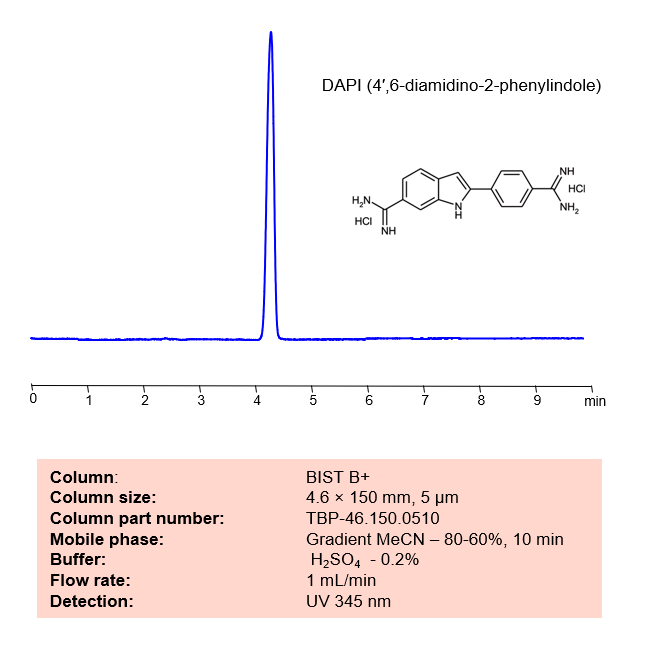| Molecular Formula | C16H19Cl2N5O |
|---|---|
| Molecular Weight | 368.3 |
| InChI Key | UJLVGXGUAMGVEX-UHFFFAOYSA-N |
| Synonyms |
|
Applications:
HPLC Method for Analysis of DAPI on BIST B+ Colum
December 7, 2022
HPLC Method for Analysis of DAPI on BIST B+ by SIELC Technologies
Separation type: Bridge Ion Separation Technology, or BIST™ by SIELC Technologies

4′,6-diamidino-2-phenylindole, also known as DAPI, is a popular fluorescent dye used for DNA staining and fluorescence microscopy. Using SIELC’s newly introduced BIST™ method, DAPI can be retained on a positively-charged anion-exchange BIST™ B+ column.
There are two keys to this retention method: 1) a multi-charged, negative buffer, such as Sulfuric acid (H2SO4), which acts as a bridge, linking the positively-charged analytes to the positively-charged column surface and 2) a mobile phase consisting of a majority of organic solvent (such as MeCN) to minimize the formation of a solvation layer around the charged analytes. Utilizing a step gradient to switch to a completely aqueous MP after 2 minutes allows for retention to occur while also preventing the method from being too long. Using this new and unique analysis method, DAPI can be separated, retained, and UV detected at 345 nm.
High Performance Liquid Chromatography (HPLC) Method for Analyses of DAPI
Condition
| Column | BIST B+, 4.6×150 mm, 5 µm, 100A |
| Mobile Phase | Gradient MeCN |
| Buffer | H3PO4 – 0.2% |
| Flow Rate | 1.0 ml/min |
| Detection | UV 345 nm |
| Peak Retention Time | 4.01 min |
Description
| Class of Compounds | Dye |
| Analyzing Compounds | DAPI, or 4′,6-diamidino-2-phenylindole |
Application Column
BIST B+
BIST™ columns offer a unique and effective way to achieve separations that were traditionally challenging or even impossible with other HPLC columns. With the use of a special mobile phase, these ion exchange columns provide very strong retention for analytes with the same charge polarity as the stationary phase, unlocking new chromatography applications. What makes BIST™ columns stand out is their proprietary surface chemistry, which results in superior selectivity, resolution, and sensitivity. These columns offer a simple, efficient solution for a variety of analytical challenges, making them an excellent choice for researchers and analysts across many different fields. To learn more about the technology that powers BIST™ columns and to explore related applications, check out https://BIST.LC.
Select options


